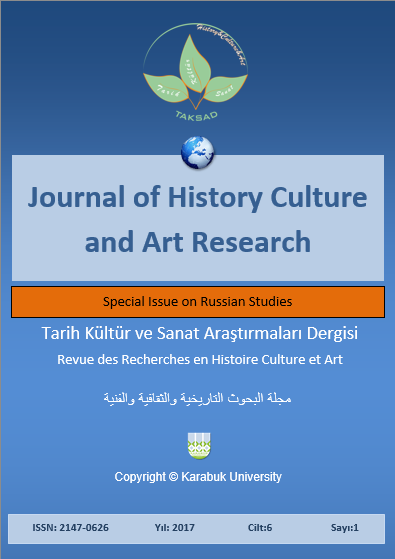Artistic-Style Features of Marat Kabirov's Intellectual Prose
DOI:
https://doi.org/10.7596/taksad.v6i5.1300Anahtar Kelimeler:
Tatar literature- The intellectual direction in literature- Intertextual communications- Style features- Hints- Symbols.Özet
This research, from an identification position in it art and style features, analyzes prosaic works of Marat Kabirov ("The mystery of yellow houses", "Goes the ghost", "A name of your angel") who represents the intellectual direction in modern Tatar literature. The subject of studying of scientific work is made by esthetic specifics of this direction of the Tatar prose, art and style features of works, representative from the point of view of the characteristic of intellectualization in national historic-literary process as qualitatively new literary phenomenon in the Tatar prose of the end of 20 - the beginnings of the 21 century. Modern literary critics mark out the most general property of all intellectual texts as belonging to modernist and postmodern literary tradition", inter-text, literary and historical hints, metaphoricalness, etc. In the analyzed M. Kabirov's works not separate images, not separate lines become metaphors, but the work in general is a difficult, polysynthetic, multiple-valued metaphor, a metaphor symbol. In these works readers gradually become as if accomplices of the event, "move" in the text of a plot as equals with the author and heroes, that there is a dialogue mode of reading of the work as one of indicators of intellectualization of prose.
Referanslar
Amineva, V. R. (2017). Symbolization as a way of art completion in the story by A. Eniki "Unvoiced testament". XLinguae European Scientific Language Journal, 10(1), 12-24. DOI: 10.18355/XL.2017.10.01.02
Galimullin, F. G.; Galimullina, A. F. & Mingazova, L. I. (2014). The development of the literatures of the people of the Volga region in multi-ethnic Russia. Journal of Language and Literature, 5(3), 248-252. DOI: 10.7813/jll.2014/5-3/42
Gilazov, T. Sh.; Karabulatova, I. S.; Sayfulina, F. S.; Kurakova, Ch. M. & Talipova, G. M. (2015). Between the East and the West: Phenomenon of Tartar Literary Criticism in the Lingvo-Cultural Aspect. Mediterranean Journal of Social Science, 6(3), 508-517. DOI:10.5901/mjss.2015.v6n3s2p508
Kabirov, M. (1999). Mystery of yellow houses. Tulpar, 5, 42-49.
Kozhevnikov, V. M. & Nikolaev, P. A. (eds.) (1987). The literary encyclopedic dictionary. Moscow.
Leyderman, N. L. & Lipovetsky, M. N. (2003). Modern Russian literature: 1950-1990th years studies. Мoscow: Prod. Akademiya center.
Magsumzyanovich, Z. A. (2014). Problems of transformation of the genre of tragedy. Life Science Journal, 11(7), 346-351.
Markova, T. N. (2003). Style tendencies in prose of the end of the 20th century: specifics of speech forms. News of USU, 27, 85-97.
Sattarova, G. G. & Sayfulina, F. S. (2016). The trailblazing functions of Symbols in the Modern Women's Prose. International Journal of Humanities and Cultural Studies (IJHCS), 3, July 2016 Special Issue, 462-467. URL: http://www.ijhcs.com/index.php/ijhcs/issue/view/23
Yusupova, N. M.; Sayfulina, F. S.; Gainullina, G. R. & Ibragimov, B. Kh. (2016). Fiction adaptation characteristics in Tatar literature of the second half of 20 century. European Journal of Science and Theology, 12(1), 213-222. URL: http://www.ejst.tuiasi.ro/issue12.html
Zagidullina, D. & Amineva, V. (2016). Avant-Garde Research in the Field of Verse Forms (based on I. Yuzeev lyrics). XLinguae European Scientific Language Journal, 9(1), 135-145. ISSN 1337-8384.
Zagidullina, F. (2006). "Sara Yortlar to sulfur". Yana dulkynda. Cauldron: Magarif Publications.
İndir
Yayınlanmış
Nasıl Atıf Yapılır
Sayı
Bölüm
Lisans
Tarih Kültür ve Sanat Araştırmaları Dergisi'nde yayımlanan tüm çalışmalar Creative Commons 4.0 CC-BY lisansı ile lisanslanmıştır.
Bunları yapmakta özgürsünüz:
- Bu eseri her boyut ve formatta paylaşabilir — kopyalayabilir ve çoğaltabilirsiniz.
- Materyalden Adapte et — karıştır, aktar ve eserin üzerine inşa et
- her türlü amaç için, ticari amaç da dahil
Alttaki şartlar altında:
Atıf — uygun bilgiyi, lisansa linki, and ve değişiklik yapıldıysa değişiklik bilgisinivermelisiniz. Sizi veya kullanımınızı lisansörün onayladığı bilgisini içermemek kaydıyla, size uygun şekilde bu işlemleri gerçekleştirebilirsiniz.
AynıLisanslaPaylaş — Eğer materyali karıştırdınızsa, aktardınızsa ya da materyalin üzerine çalıştınızsa, ancak aynı lisans ile dağıtabilirsiniz.
- Ek sınırlamalar yoktur — Lisansın izin verdiği hakları başkaları üzerinde kanunlarla ya da teknolojiyikullanarak sınırlayamazsınız.







